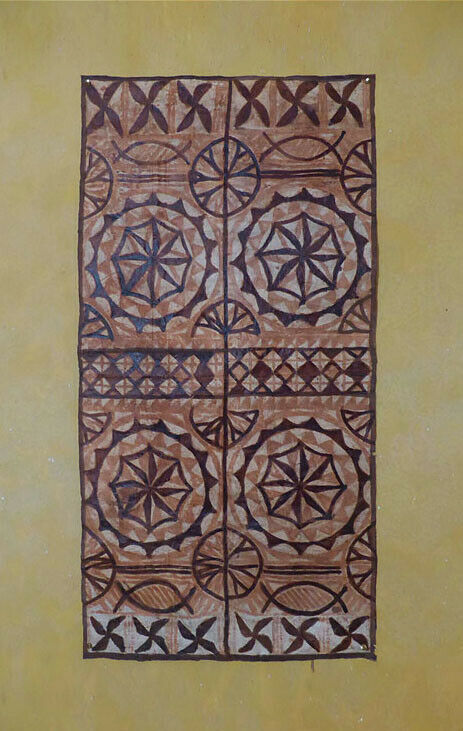-40%
Vintage Siapo with interesting star motifs.
$ 102.96
- Description
- Size Guide
Description
Vintage Siapo with Sun and Compass motifs.The focus is on the star symbol which in this case represents the sun all year round,
also the compass motif important for navigation.
The other half circles are tree branches in various stages of seasonal growth.
This Siapo is in excellent strong condition.
Dimensions: 1060mm x 540mm.
......................................................................................................................
If you are interested in Tapa cloths, (Kapa, Bark cloths, Masi, Ngatu, Siapo or PNG Bark cloths)
I have a few more listings on Ebay and will combine postage, if you'll buy 2 only pay postage for 1.
......................................................................................................................
Background info:
Tapa cloths are made of bark fibers, a type of cloth made from the bast, or inner bark strips of specific trees, mainly the mulberry tree, although several species of breadfruit and fig trees are also used.
As Tapa cloths are hand made with symbols and designs specific to a particular island group, region,or township, every single one is one of a kind and unique.
......................................................................................................................
Info about Samoan Siapo.
Siapo, also called Tapa cloth, is one of the oldest Samoan cultural art forms. For centuries Siapo making has been passed down the generations. It is a major art form and an important symbol of Samoan culture. Tapa cloths have been used for various purposes throughout Samoan history, including as traditional clothing, burial shrouds, and ceremonial items.
The preparation process involved in the materials used to create Siapo is an art itself.
The bark used to make siapo comes primarily from the mulberry family. The tree stalk is carefully tended so that is grows straight with very few branches; it is harvested once it reaches one-to-two inches in diameter.
The bark is stripped off the stalk in one even pull. From the stripped bark the soft inner bark, called the bast, is separated from the tough outer bark. Moistened bast is scraped with 3 different clam shells, varying in sharpness, to clean away any remnants of the discarded outer bark. The scraping also softens and spreads the fibers. The narrow strip of bast is then placed on a wooden anvil and pounded with a wooden beater. This beating process causes the bast to flatten and gradually spread out to become wide, thin pieces of cloth. This unfinished cloth, called u'a, is weighed down with stones to be dried and bleached by the sun. To create various sizes of cloth, strips of u?a are pasted together with arrowroot paste, called masoa. Holes are patched with u'a and masoa. Once the cloth fully dries, it is ready to be decorated.
Dyes used in decorating siapo are derived from a number of plant sources. O'a, which is extracted from the bark of the blood tree, is a brown dye that is the base for all other dyes; as it ages it darkens from a pale tan to a dark brown. Black dye, or lama, is made by burning the nut of the candle nut tree, the charcoal is collected and mixed with o'a to make lama.
Loa is a bright red dye made from seeds of the lipstick tree mixed with o'a.
Yellow dye, ago, is extracted from tumeric root juice, years ago it was a popular color but is known to fade over time.
The main design patterns or symbols used in Siapo are reflections of elements in the Samoan environment.
Traditionally there are thirteen symbols used in Siapo, most of these represent pandanus blossoms and leaves, breadfruit leaves, trochus shells, footprints and other bird forms, starfish and navigating symbols as compass sun and moon.
These motifs are typically presented within a grid created by rectangular or oblong sections on larger Siapo.
Two techniques are used in creating the designs: siapo 'elei (the rubbing method) and siapo mamanu (the freehand method).
Siapo 'elei uses a design board (upeti) to imprint designs on the bark cloth. An unfinished cloth is placed on a upeti that has been covered with dye; the top surface is then rubbed to transfer the design from the board to the cloth.
Siapo are still commonly used in Samoa for traditional purposes as well as for everyday uses such as bed coverings, room dividers, household decorations, and as tourist items.
...............................................................................................................................................................
About Tapapacifica:
Living in New Zealand, I have been collecting Pacific Tapa cloths for about 30 years through the years have gained a lot of knowledge about the subject.
As I've reached my limit space wise I decided to sell a large portion of my collection off and over the last 6 years have sold a number of Tapa cloths to collectors, galleries, resorts, libraries, Government departments and museums.
A small part of my collection is kept on loan in museums in many parts of the world.
Customer satisfaction is very important to me.
Items are carefully packed, an item which arrives damaged will be refunded.
For more info: www.tapapacifica.com.
Thanks for your interest, questions are always welcome.
......................................................................................................................










